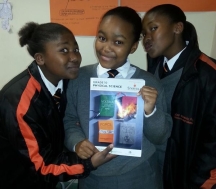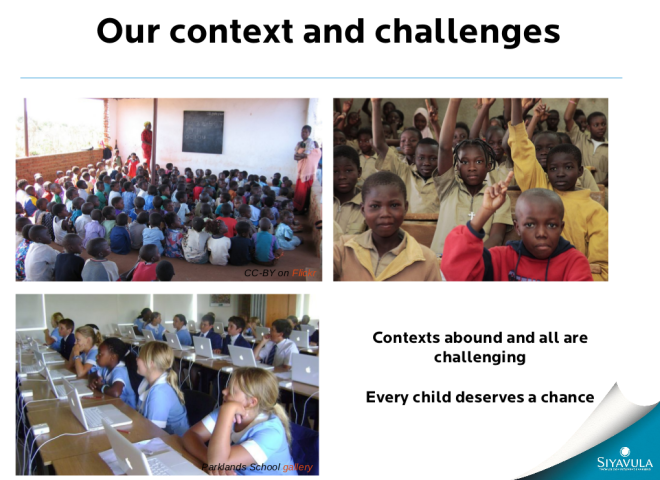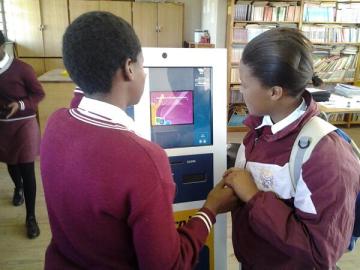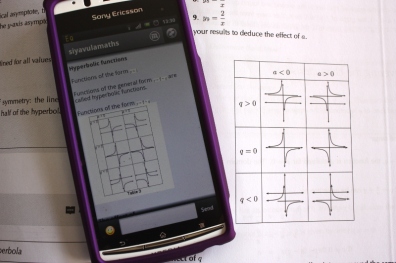This week, a story was sent around on the OKFN open education mailing list (subscribe here) about the devastation in Syria and how this is affecting the children. The context is that there are now about 7 million Syrian children living in refugee camps. Many children are therefore not receiving an education, either because the refugee schools are too full or it is very difficult to transfer in the chaotic system. Here is a quote from the article:
“I had top grades – I wanted to study communications at university. I was in my last two years of school [when the conflict broke out], but now I have no chance to finish my education,” he told us. “To get registered in school here, they told me I must bring my school papers from Syria. How is this possible when my school and house were completely destroyed? I told them I could sit an exam to show them, but they said they have too many students already. I’ve tried to study by myself at home, but I have no access to books; I can’t learn anything. I had such hopes for a good future, but now they’ve been destroyed.“
The question was posed “Can open educational resources help and if so, how do they obtain them?”. This is a devastating story, but also brings to light broader questions of making open education accessible in developing countries amidst the many challenges, the most prominent one being the lack of infrastructure and internet access. This highlights crucial differences between developed and developing countries which should be taken into account when creating and distributing OER and assessing the potential impact of open education. In light of this, I would like to discuss some of our experiences at Siyavula, as we are also working within a developing country to deliver open educational resources.
In South Africa, we have an enormous range of contexts within which people are trying to learn. We interact with some schools where every child has an iPad, and yet most schools are severely under resourced, often without the basic infrastructure such as walled classrooms and toilet facilities, nevermind an internet connection.
(See the rest of the slides from this presentation here.)
How then do we deliver educational content to satisfy all of these learners’ needs?
Over and above making our content available on our websites and as ePubs, two forms of delivery are crucial to us in South Africa, and I would think this would apply generally to developing countries. These are print resources and mobile phones.
Distributing print resources
 We are in the unique position in South Africa where our government, the Department of Basic Education, has printed and distributed our textbooks to all learners in government schools. That is about 10 million books so far, at a cost of about $2 per book. The feedback we have had has been over whelming, as many learners never had any textbook before, and their teachers are most often under qualified. Have a look at our Siyavula Facebook page for some of the feedback that constantly streams in directly from learners who have received our textbooks for free.
We are in the unique position in South Africa where our government, the Department of Basic Education, has printed and distributed our textbooks to all learners in government schools. That is about 10 million books so far, at a cost of about $2 per book. The feedback we have had has been over whelming, as many learners never had any textbook before, and their teachers are most often under qualified. Have a look at our Siyavula Facebook page for some of the feedback that constantly streams in directly from learners who have received our textbooks for free.

Mobile phones
My take home message!
OER, even that produced in developed countries, needs to be optimised for this kind of delivery (especially mobile), if you want your content to truly be as accessible and open as possible! If OER developers and curators satisfy the most basic (open) formats for content delivery, then the content will have a much further reach.
By sharing some of our experiences, I hope that OER producers and advocates in first world countries will first and foremost consider the “constraints” of developing countries when producing OER, as this is where open education has the most potential to have the biggest impact.





hello… such a noble cause for trying to help Syria. When was it please? We are a group of students from the BSc Ed tech in Mauritius and we chose you to work on our project for OER. We were fascinated by your work and motivation.
LikeLike
Hi there, thanks for the comment. In this blog post, I was referring to an article that was sent around a mailing list in 2014 about the plight of educating children in Syria. However, my blog post is not about Syria, but rather speaking about our experiences in South Africa (at Siyavula) and using OER for Maths and Science education here in our country.
LikeLike
I am sure this is an eye opener to many people. we have the gadgets- phones… everybody is using it for chats and other social conversations
but why are we not using the same to teach our nations. if indeed we want to have open resources that are really open and accessible to many… then this is the way to go.
LikeLike
Wow, thank you so much. I am kind of a novice in the OER area, and this post and the videos have really opened my eyes to how just posting things online isn’t really helping out as many people as we’d like to think. I don’t have anything terribly useful to add, except to say how much I appreciated what I have learned from this post. I was vaguely aware of Siyavula, but will now be doing more research into the work this organization does, and also into how OER can be made more useful to more people in ways I hadn’t realized before.
LikeLike
Hi Christina! Thanks for the comment – I’m really glad you found it helpful. Let me know if you want to know anything more about Siyavula or open education in South Africa.
LikeLike
I see a connection to the idea beyond cloud-based document storage to providing access to cloud-based processing. It is possible that the complicated creative projects that many students around the world have a desire to build are available to them, even if the antiquated devices they are making use of don’t have the direct tool. Your article starts me on the thinking that equality of access is now as important as the idea of universal education as a basic human right once was. So thanks.
LikeLike
Thanks, it’s a pleasure! I completely agree that often we speak about equality in education, but that access to that education is a huge barrier and needs to be considered.
LikeLike
Based on the situation in Syria OER is the best method to adopt to help with the fulfillment of those children dreams. It is beneficial in broadening the use of alternatives to text books and it reduces the cost of learning materials to students. Conversely, global adoption of OER is a good initiative but also has its disadvantages. It is beneficial in broadening the scope of learning resources, through its digital form it provides room for flexible and or self-paced learning. However, in adapting to OER the issue of quality available resources may be a challenge if there is no common standard for review of OER’s. There may always be a need to check accuracy and quality of content. Finally, in underdeveloped countries the lack of infrastructure and internet access will also be an issue and will need to be address in creative ways so everyone will be reached and be able to contribute meaningfully .
LikeLike
Hi Andrene. Thanks for the comment. I think the question around the quality control of OER comes up a lot. But, I also think that over time, the more an OER is used, it starts to grow a community around its use which then feeds back into its continued revision as users perhaps modify, adapt, revise and share back an updated version. We have a similar feedback cycle that is starting to take place with people that use our open textbooks and content. We also develop our content collaboratively and openly with a large group of volunteers. These volunteers (teachers, academics, post graduates, government officials, and general public) then take ownership of the OER and want to see its growth and development over time as they were part of the initial process. So, as the community of users grow, they also send in feedback to us and help with future revisions, which is really exciting.
Regarding your last comment, yes, exactly, internet access around Africa and other developing countries is an issue. But, i am always amazed at what comes out of Africa! I think this is where real innovation takes place as people on our continent are having to think really creatively to deal with their daily challenges. For example, have a look at this really exciting initiative taking place in Kenya, the Kibera mesh network to increase access to education and resources, especially in the slums: https://goteo.org/project/kibera-mesh-network/home
Some quotes about what the project is aiming to do:
LikeLike
Interesting use of the technology and resources. In my Small Island Developing State the use of technology especially the use of cell phone is ever increasing however, I am not sure that the students are aware of or if they have ever considered that the cell phone smart or otherwise is an educational tool. Even worse is that as educators we have not on a national scale incorporated the use of these mobile phones (that our students generally speaking have become so attached to) in our teaching learning experiences. Thanks for sharing.
LikeLike
Thanks for the comment. I completely agree. We need to embrace what students are using in their daily lives so that what they do in class is not a disconnected learning experience from the real world. But, educators also often fall into the trap of trying to use technology just for technology’s sake. In the content I developed, I have tried to advocate for activities where cellphones can be used in a meaningful way, for example using the “Star tracker” app when we do astronomy in Natural Sciences or getting learners to take photos of the organisms they are studying in their local ecosystem and uploading them to “iSpot” to record the local biodiversity in South Africa. This way learners at school level are also contributing to real science.
LikeLike
Just seen this infographic which highlights the reach of Mxit in South Africa, and the devices and operating systems used: http://www.pinterest.com/pin/451556300110003345/
LikeLike